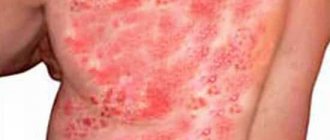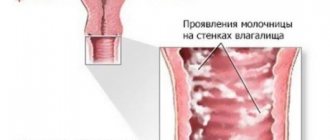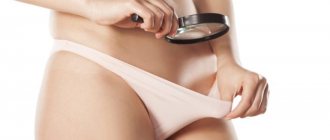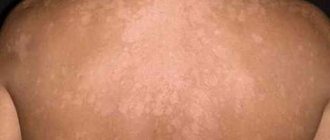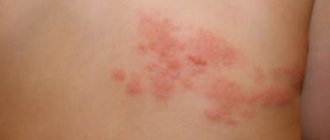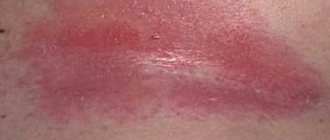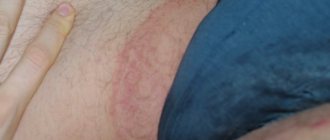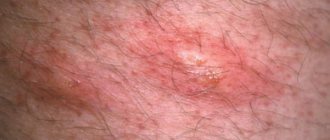Causes of rashes on the chest in women
Rashes on the chest in women can occur along with severe itching and irritation. Such symptoms occur in the presence of various skin diseases, an infectious process, or as a manifestation of an allergy.
Urticaria is an allergic reaction that manifests itself in the form of continuous redness, on which blisters are observed. The diameter of the lesions can reach two centimeters, depending on the allergen.
Sometimes the disease causes painful sensations at the site of the rash, which become burning and irritating. With urticaria, the body temperature often rises, the redness is very itchy.
Measles, another illness that can cause a rash that spreads to the chest, occurs more often in women . Associated signs of measles:
- high fever, heat;
- headache that is constant, aching in nature;
- inflammatory process on the mucous walls of the nasopharynx;
- red spots on certain areas of the epidermis;
- catarrhal inflammation in the eye area.
Measles is a dangerous infectious disease that requires complete isolation of the patient. At the slightest suspicion, you should immediately consult a doctor.
Rubella is a pathology caused by a viral nature and does not cause serious complications. Rashes in the chest area, as a rule, do not itch and do not cause severe discomfort. An additional sign is severe enlargement of the lymph nodes.
Allergic dermatitis causes severe redness of the skin, the rash spreads throughout the body, including the chest. Sometimes eczema begins, which can leave small scars on the epidermis.
A skin rash that occurs between the mammary glands and under the sternum is one of the most pronounced signs of syphilis. This is a dangerous disease caused by Treponema, an infectious agent. Pathogenic organisms of this nature enter the female body through microcracks formed in the epidermal layers of the skin.
Often the rashes begin with ordinary heat rash. The reason may be uncomfortable, constricting underwear, active work of the sebaceous glands. Miliaria is easily corrected and does not require serious medical interventions.
In women, rashes on the chest can be a sign of serious hormonal imbalance, lack of estrogen and improper functioning of the reproductive system. The symptom can be eliminated by starting treatment for gynecological diseases.
Experts identify a number of other reasons why women experience rashes in the chest area:
- poor nutrition, lack of nutrients;
- alcohol abuse;
- lack of a normal sleep schedule;
- endocrinological disorders;
- failure to comply with hygiene standards.
Reasons for appearance
The human skin contains many glands, ducts, hair follicles and other structures. The sebum produced forms a protective barrier against infections from the external environment. Epidermal cells multiply, renew themselves, die and exfoliate. This process continues endlessly.
The mixing of subcutaneous fat and the stratum corneum contributes to the appearance of dirt, which a person washes off during hygiene procedures. It's difficult to eliminate.
Substances used for external skin care cause dryness of the epidermis. As a result, the skin and the structures located in it are vulnerable to environmental irritants (dirt, pathogenic microflora).
If the epidermis is cleaned incorrectly and untimely, the sebaceous and sweat glands become clogged. The accumulated secretion contributes to the appearance of acne. When bacteria attach, an inflammatory process occurs, which results in a pimple with purulent contents inside.
Why does a rash appear on the chest in men?
A rash that begins to appear on a man’s chest can signal various pathologies. It is important to pay attention to whether accompanying symptoms appear, how long the illness lasts, and in what form it manifests itself.
So, experts identify the following causes of a rash starting on the chest in men:
- infectious diseases, which may include chickenpox, scarlet fever, rubella, measles, acute pharyngitis, pyoderma, lichen and spotted fever;
- severe nervous tension, stress, nervous system disorders;
- pathologies of internal organs, including imbalance of intestinal microflora, pathologies of the kidneys, liver;
- tight clothes, underwear;
- prickly heat;
- problems related to the prostate gland;
- lack of personal hygiene.
If the rash does not go away within a few days, and the painful and burning symptoms on the chest only intensify, then you should urgently consult a qualified doctor.
The main factors in the development of rashes on the chest and under the breasts
So, a rash developing on the chest, back, neck is not a separate disease, it is just a pronounced sign of an existing pathology. Not all people are at risk; for the pathological process to begin, certain factors are necessary:
- weak immunity. A low level of hemoglobin indicates a decrease in the body's protective function. The production of natural, own interferon, which fights pathogenic organisms coming from outside, is suspended. With weakened protection, the human body is more susceptible to various kinds of infectious agents, viruses and bacteria;
- wearing clothes made from synthetic fabrics. If a small rash appears on your chest that itches, then perhaps this is an allergic reaction that occurs due to poor-quality clothing. Hives that appear on the chest begin to itch and itch;
- lack of nutrients in the body;
- wrong lifestyle;
- use of decorative and care products with strong fragrances;
- tendency to allergic reactions;
- the presence of chronic diseases of internal organs;
- genetic predisposition.
Types of acne
Acne under the mammary glands is divided into several types:
The condition of the skin under the breasts depends on the quality of the underwear.
Inflamed. This type includes pustules, papules, cystic acne and nodules. This rash is red in color, severely painful and itchy.- Uninflamed. These are comedones and wen. They occur asymptomatically, due to blockage of pores with sebum and dirt.
Also, acne under the breasts is divided according to the type of content:
- serous;
- purulent;
- hemorrhagic.
Growths between breasts
Growths found between the breasts are a dangerous symptom that can be caused by:
- human papillomavirus;
- the presence of a benign or malignant tumor;
- deformation of the ribs;
- degenerative-dystrophic diseases.
It is important to detect an unpleasant symptom in time and consult a doctor. The skin in this area may become covered with acne and pimples.
Pimple-like rashes appear
If a severe rash appears on the sternum, manifesting itself in the form of pimples, then you should pay attention to the accompanying symptoms. Upon examination, the doctor can diagnose the following pathological processes:
- metabolic disorders in the body. In this case, white pimples will form on the back, chest, neck and skin under the breasts;
- clogged sebaceous ducts. Small pimples with a scarlet tint will appear not only on the chest, but also on the skin of the face;
- ingrown hair. As a rule, it is easy to diagnose; sometimes you can see hairs or blackheads in the center of the pimple;
- allergy;
- viral diseases. The pimples will look more like blisters filled with liquid;
- predominance of fungi in the body.
Relief of condition
Undoubtedly, itching and redness on the chest cause a lot of inconvenience. However, you can alleviate the condition; medications will help with this. It is recommended to take calcium supplements and antihistamines. You should also take warm baths every day; you should add decoctions of oak string, bark, and oregano to the water.
It is important to remember that its temperature should not be higher than 37 C. You can use an alcohol solution of calendula to care for irritated skin; ointments containing antihistamines or menthol are also suitable. In addition, it is recommended to try making lotions with oat bran, celandine or chamomile flowers. Compresses made from strong iced tea give good results. However, you need to be careful with them so as not to chill the mammary gland. Otherwise there will be many more problems.
Effective treatment methods
So, treatment must be comprehensive. As a rule, the main goal is to eliminate unpleasant symptoms and the lever for their ignition. Depending on the cause of pimples and rashes, the doctor prescribes the following medications:
- anti-inflammatory drugs;
- antihistamines;
- painkillers with a strong analgesic effect;
- antimicrobial agents;
- antibacterial drugs;
- gels, ointments, emulsions for external (sometimes targeted) use.
Among the methods of traditional medicine, the most preferable are compresses and lotions made from decoctions based on herbal plants:
- chamomile;
- mint;
- rose hip;
- St. John's wort;
- series.
The herbs listed have an antiseptic effect, restore the skin and strengthen the epidermal cells.
The views are different, sometimes contrasting
Depending on the amount of time passed, several degrees of rash are distinguished:
- The simplest degree is characterized by mild redness and swelling, which may cause slight itching. When wearing a bra, unpleasant sensations arise as the fabric and bone rub against an already damaged area of the body.
- The average degree is characterized by noticeable redness and the appearance of small nodular formations.
- The complex degree is characterized by severe damage, wounds with purulent deposits.
The photo shows rashes and redness under the mammary gland:
The nature of the rash can also vary and differ in its manifestations. Stands out:
- rash;
- burning;
- suppuration;
- discharge;
- peeling;
- redness;
- itching in the breast area.
In this case, the rash can take the following form:
- Scaly. The skin becomes dry and dead, forming small particles of epithelium on the surface. They vary in size (plastic, small and large) and color (dark, yellow and whitish).
- Bubbly. It is a kind of closed container made of skin, which contains a small volume of liquid. Typically the diameter is ranged within half a centimeter.
- Crusted. It is formed due to the drying of ulcers and stands out for its unusual shape. The internal contents give a characteristic shade (serous, purulent or mixed).
- Nodular. The nodule is located within the boundaries of the epidermis. Depending on the type of disease, such formations may be inflammatory. Plaques of impressive size appear, taking on a round, oval or polygonal shape. Based on volume, they are divided into flat, spherical and conical.
- Ulcerative. It is detected only if the papule is opened. The sides of the ulcer do not differ in characteristic density, as does the bottom.
- Erosive. Forms only after the abscess has disappeared.
Possible consequences and complications
If you ignore the first signs of pathologies, the following complications may appear:
- a small rash will spread throughout the body;
- boils form on the skin;
- the disease will become a chronicle;
- additional diseases will appear.
Metabolic processes in the body may be disrupted. In addition, the pores become dirty and the functioning of the sebaceous glands is disrupted.
In the absence of long-term treatment, the patient may be left with scars from pimples that cannot be corrected conservatively, only through surgery. It is worth paying attention to existing shortcomings in a timely manner.
It should be remembered that skin rashes can be caused by various reasons. That is why diagnostics performed competently and quickly play a significant role. Try to see a doctor more often and do not self-medicate.
Causes and treatment of rash
The causes of small acne on the face can be completely different:
- Poor nutrition. You can eat poor quality food one time and get severe rashes. But eating sweets and fatty foods in large quantities also provokes acne.
- Incorrect care. Using cheap skin care products, improper cleansing before bed, cosmetics that are inappropriate for your skin type.
- Allergy. In this case, the rash may be accompanied by severe itching.
- Subcutaneous mite - demodex. Small pimples may be a result of the activity of subcutaneous mites.
- Hormones. As soon as hormonal changes begin in the body, it immediately manifests itself in the form of acne, single, or in the form of a rash.
- Gastrointestinal diseases.
- Heredity. These can be chronic, hereditary diseases, which result in a small rash on the face.
Cosmetologists and dermatologists distinguish several types of acne.
- Comedones. If the sebaceous glands do not work properly, the pores can become clogged with a sebaceous plug, which subsequently causes suppuration. Comedones can be single or in the form of a profuse rash.
- >Milia. Dense nodules located under the skin, their color is white, they can also fester.
The best option is to go to a specialist for professional advice. Only a doctor can prescribe effective medications, depending on the severity of the disease.
A dermatologist may send you for tests or to specialists for examination, for example:
- to an endocrinologist;
- gynecologist;
- allergist;
- gastroenterologist;
- cosmetologist
In each individual case there will be an individual approach, and a specific treatment will be prescribed.
Treatment procedures
A cosmetologist can prescribe procedures aimed at combating small pimples on the face. First of all, he will cleanse and exfoliate the skin, then, if necessary, he will prescribe a comprehensive treatment.
The most popular are:
- Laser peeling is a painless procedure. Removal of the rash occurs delicately, the skin is not injured. In one procedure you can get rid of acne;
- Superficial peeling with fruit acids. Exfoliates well, eliminating sebaceous plugs. It is used in a course of 7-10 procedures depending on the severity of the disease;
- Ultrasonic cleaning – eliminates acne and brings the skin into proper shape;
- Vacuum peeling – applicable for severe suppuration on the face.
Important: do not carry out these procedures at home; only a professional cosmetologist can correctly calculate the preparations and perform high-quality cleaning. Cleaning is the first step in the fight against rashes
If there is no improvement, the following treatment may be prescribed:
Cleaning is the first step in the fight against rashes. If there is no improvement, the following treatment may be prescribed:
- Ozone therapy effectively fights germs. One treatment can bring acne to a mature state. Injections are made under the skin, 5-7 procedures are required.
- Subcutaneous injections with antibacterial drugs, which contain:
- triclosan;
- salicylic acid;
- chamomile extract;
- erythromycin;
- witch hazel.
zinc oxide;
- Retinoic ointment - corrects the functioning of the sebaceous glands and effectively resists comedones.
Curiosin not only removes acne from the skin, but also prevents the appearance of scars.
